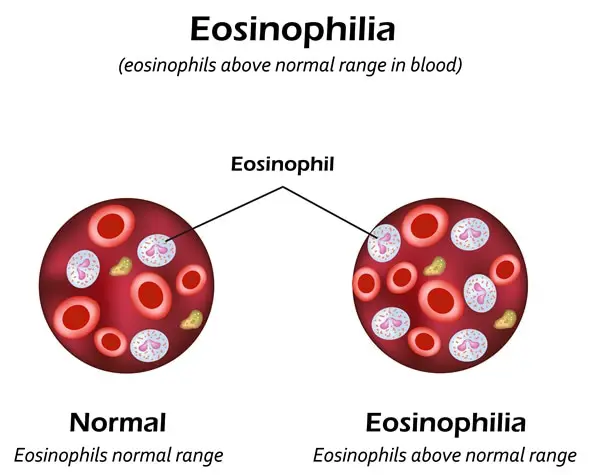Physical Address
304 North Cardinal St.
Dorchester Center, MA 02124
Physical Address
304 North Cardinal St.
Dorchester Center, MA 02124

Eosinophilia is characterized by an eosinophil count that is elevated.
White blood cells called eosinophils fight infections. Malignancy, an allergic reaction, or a parasite infection are the most frequent diagnoses for this condition. Elevated eosinophil counts in diseased or inflammatory tissues are referred to as blood eosinophilia or tissue eosinophilia.

Tissue eosinophilia may be present in samples of certain fluids, such as mucus secreted by nasal tissues, or samples obtained during exploratory surgery. If you have tissue eosinophilia, the number of eosinophils in your bloodstream is generally normal.
Blood eosinophilia can be detected with a blood test, usually in conjunction with a complete blood count. Eosinophilia is generally understood to be the presence of more than 500 eosinophils per microliter in the blood.An eosinophil count greater than 1,500 cells per microliter for several months is referred to as hypereosinophilia.
The reason for the elevated eosinophil count will influence symptoms to some extent if you have eosinophilia. You might not have any symptoms even if your eosinophil level is somewhat raised
Typical signs include (EOSINOPHILIA) – :
There are many causes for an increased eosinophil count. Some of the causes are benign and don't need much care. It is not unusual for the increased count to be temporary and to go down on its own.
On a complete blood count (CBC), eosinophilia is detected, like the majority of blood diseases. One type of white blood cell, called an eosinophil, can be seen in the differential section of the complete blood count (CBC). The differential shows how many neutrophils, lymphocytes, monocytes, eosinophils, and basophils (each type of white blood cell) are present in the blood.
Your healthcare provider will begin investigating the cause of the eosinophilia after diagnosing it; occasionally, this necessitates a referral to a haematologist. The quantity of eosinophils present (absolute eosinophil count) can classify eosinophilia.
500–1500 cells/mL for mild
1500 – 5000 cells/mL, moderate
Significant: > 5000 cells/mL
Homeopathy is one of the most well-known holistic medicinal philosophies. The optimum treatment is chosen using a holistic approach, which relies on individualization and similarity of symptoms. Only by eliminating all of the signs and symptoms that are producing them will the patient be able to fully recover their health in this way. Some eosinophilia symptom remedies include the ones listed below:
When someone feels weak, exhausted, and fatigued all the time, medication is indicated. In such circumstances, energy levels are very low. There is a pronounced prostration. Due to their weakness, such a person would typically dislike any physical activity or exertion. By raising haemoglobin levels, homoeopathic remedies for weakness help with recovery and energy restoration in such circumstances
When suffering from the flu, a person in need of this treatment feels chilly, worn out, and restless with anxiety. Even though they may be thirsty, they frequently drink little sips. Vomiting and bitter diarrhoea or nausea with burning pain could happen if the digestive tract is affected. A wet, runny nose with intermittent sneezing and a dry or wheezing cough are common symptoms of respiratory flu. Typically, the person feels cold throughout their body while their head feels warm.
When this treatment is recommended for influenza, the patient may experience a high temperature, violent chills, intense nausea, and abdominal cramping (or, if the flu is respiratory-related, a painful cough and restricted breathing). The usual symptoms include headache, heightened sensitivity to sound, strong light, and smells. An individual who requires Nux vomica is frequently quite agitated, feeling worse with effort and worse with any form of cold.
If a person has a dry fever that alternates with sweating, facial flushing, and a very sore throat with swollen tonsils, this therapy might be useful. Ear pain and puffy eyes are possible symptoms. The use of cold remedies and exposure to chilly air may provide comfort. The regular level of thirst is minimal despite the temperature. The person can be quite impatient and despise interruption.
When this treatment is required for the flu, the patient has a fever, a face that flushes quickly, feels extremely weak, and is woozy. You may get a headache, hoarseness, sore throat, and cough. When the digestive system is the focus, nausea or vomiting and stomach pain frequently happen. A person in need of this treatment frequently has intense anxiety and longs for company and assurance from others. Strong thirst coupled with a propensity to throw up when liquids warm up in the stomach are clear signs of phosphorus.